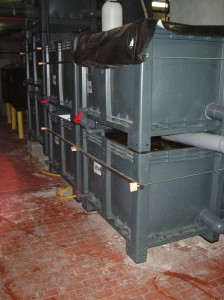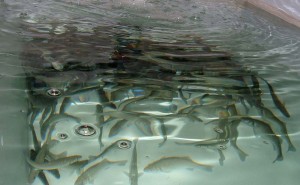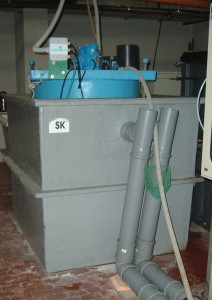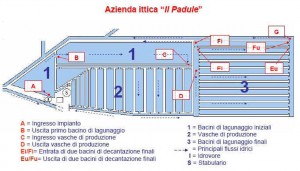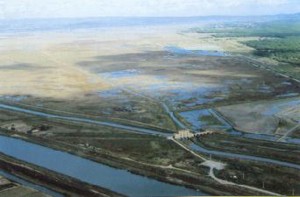Recirculation systems represent an important technological improvement of traditional aquaculture, in terms of environmental impact and of product quality. In this type of structure, effluent from fish tanks is regenerated by filtration and settlement, stabilized to reach standard chemical and physical parameters, and re-used to refill tanks.
Main advantages are: reduced environmental changes inside the tanks, partial protection of product from pollution by toxicants (even toxic algal blooming), lesser food escape, water consumption and effluent volume. Request for new water is dependent from leakage, accidental or during washing procedures of tanks, and approximate only 5% ca of the total volume of the implant.
Two main types of re-circulation systems are produced: closed water type is more apt for experimental, low productive structures, and open-sky implants, used for commercial production.
The figures in this page opens in a larger windows by clicking on them.
- Closed water re-circulation systems
The Unit’s laboratories are equipped with a pilot closed water re-circulation system, utilized for fish rearing, experimental challenges and experimentation of new technological equipments, studies on the biofilters, including their microbiological aspects.
The system is controlled by a video cam that permits remote control at every time, linked to a software for remote detection of principal parameters.
To read more, follow this link.
- Open-sky re-circulation systems
The Unit’s team actively cooperates in management of an intensive, experimental farm with land-based tanks (Il Padule, Castiglione della Pescaia, Gr, Italy). The aquaculture is settled in a brackish lagoon, communicating with the Tyrrhenian Sea. Brackish waters characterizing today lagoon are the result of hydraulic drainage well-conducted in the past two centuries: a mix of tidal marine and fresh waters, with partial effluents from the farm, feed the tanks for fish production Effluent from growing ponds is decanted, oxygenated and purified. At the end of this treatment, water re-circulates in part (ca 30%) and is reused to refill ponds.
A schema (top) and an aerial picture (bottom) of the open-sky system described above.
